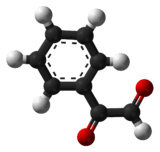Phenylglyoxal
 | |
 | |
| Names | |
|---|---|
| IUPAC name
Phenylglyoxal | |
| Other names
oxo(phenyl)acetaldehyde 1-phenylethanedione | |
| Identifiers | |
| 1075-06-5 (monohydrate) 1074-12-0 (anhydrous) | |
| ChemSpider | 13470 |
| |
| Jmol-3D images | Image |
| PubChem | 14090 |
| RTECS number | KM5775180 |
| |
| UNII | N45G3015PA |
| Properties | |
| Molecular formula |
C8H6O2 |
| Molar mass | 134.13 g·mol−1 |
| Appearance | yellow liquid (anhydrous) white crystals (hydrate) |
| Density | ? g/cm3 |
| Melting point | 76 to 79 °C (169 to 174 °F; 349 to 352 K) (hydrate) |
| Boiling point | 63 to 65 °C (145 to 149 °F; 336 to 338 K) (0.5 mmHg, anhydrous) |
| forms the hydrate | |
| Solubility in other solvents | common organic solvents |
| Hazards | |
| Main hazards | toxic |
| R-phrases | 22-36/37/38 |
| S-phrases | 22-26-36 |
| Related compounds | |
| Related aldehydes |
3,4-Dihydroxyphenylacetaldehyde |
| Related compounds |
benzil glyoxal acetophenone |
| Except where noted otherwise, data is given for materials in their standard state (at 25 °C (77 °F), 100 kPa) | |
| | |
| Infobox references | |
Phenylglyoxal is the organic compound with the formula C6H5C(O)C(O)H. It contains both an aldehyde and a ketone functional group. It is yellow liquid when anhydrous but readily forms a colorless crystalline hydrate. It has been used as a reagent to modify the amino acid, arginine.[1]
Properties
Like some other aldehydes, phenylglyoxal polymerizes upon standing, as indicated by solidification of the liquid. Upon heating, this polymer "cracks" to give back the yellow aldehyde. Dissolution of phenylglyoxal in water gives crystals of the hydrate:
- C6H5C(O)COH + H2O → C6H5C(O)CH(OH)2
Upon heating, the hydrate loses water and regenerates the anhydrous liquid.
Preparation
Phenylglyoxal was first prepared by thermal decomposition of the sulfite derivative of the oxime:[2]
- C6H5C(O)CH(NOSO2H) + 2 H2O → C6H5C(O)CHO + NH4HSO4
More conveniently, it can be prepared from methyl benzoate by reaction with KCH2S(O)CH3 to give PhC(O)CH(SCH3)(OH), which is oxidized with copper(II) acetate.[3] Alternatively, it can also be prepared by oxidation of acetophenone with selenium dioxide.[4]
References
- ↑ Kenji Takahashi (1968). "The Reaction of Phenylglyoxal with Arginine Residues in Proteins". J. Biol. Chem. 243 (23): 6171–9. PMID 5723461.
- ↑ H. von Pechmann (1887). "Zur Spaltung der Isonitrosoverbindungen". Chem. Ber. 20 (2): 2904–2906. doi:10.1002/cber.188702002156.
- ↑ Mikol, G. J.; Russell, G. A. (1973). "Phenylglyoxal". Org. Synth.; Coll. Vol. 5, p. 937
- ↑ Riley, H. A.; Gray, A. R. (1943). "Phenylglyoxal". Org. Synth.; Coll. Vol. 2, p. 509